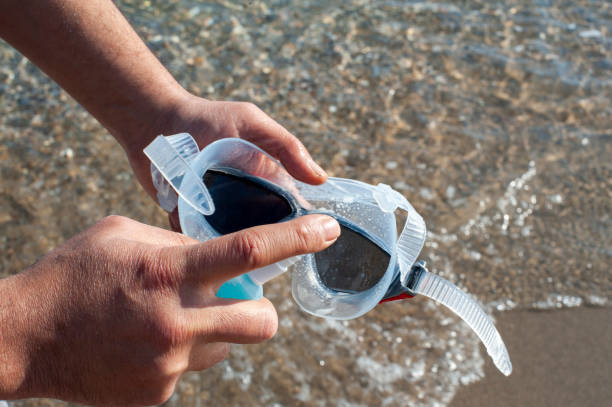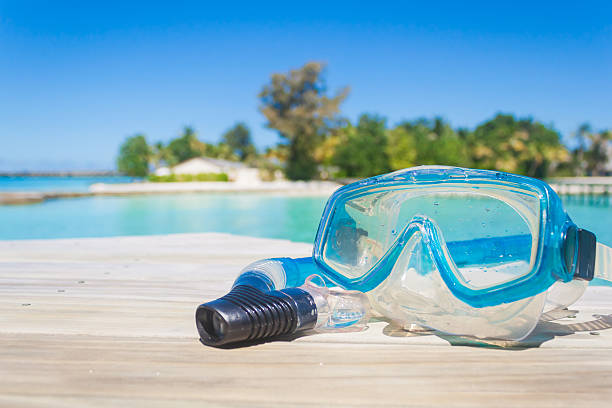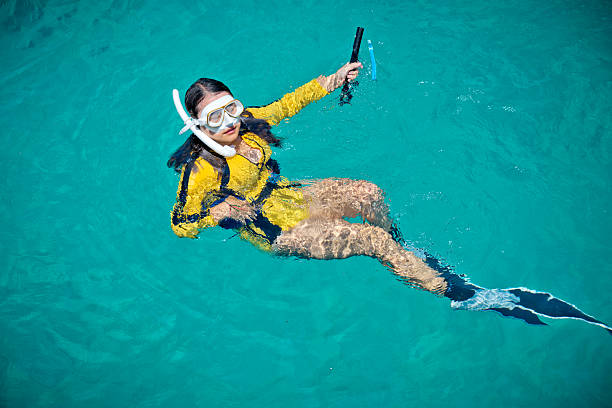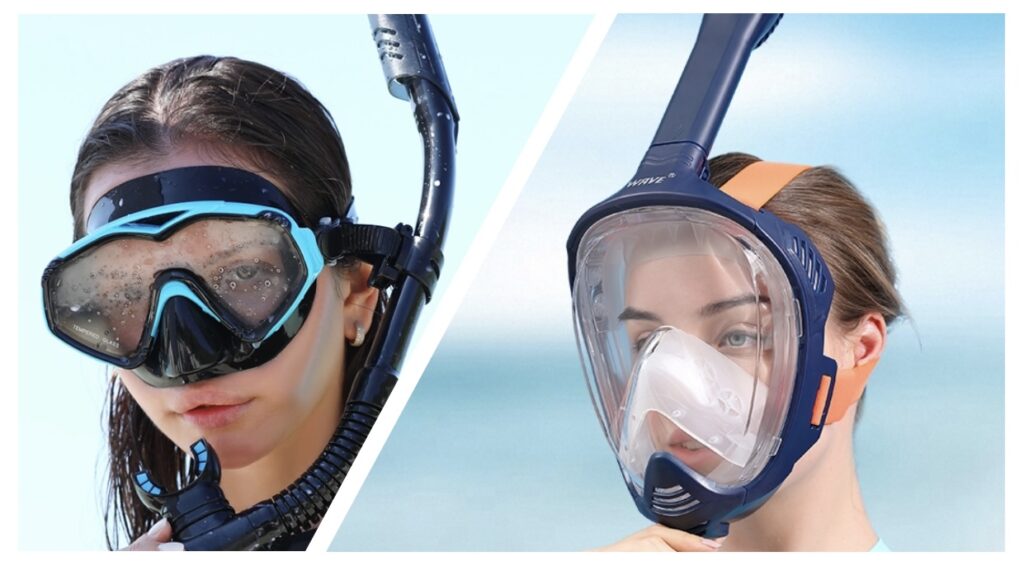
Schnorcheln ist eine beliebte Aktivität, die es ermöglicht, die lebendige Unterwasserwelt zu erkunden. Ein wichtiger Aspekt dieser Aktivität ist die Wahl des richtigen Schnorchelmaske, was das Gesamterlebnis stark beeinflusst. In diesem Artikel gehen wir auf die Debatte über Vollgesichts-Schnorchelmasken im Vergleich zu herkömmlichen Schnorchelmasken ein und untersuchen ihre Vor- und Nachteile, um Ihnen eine fundierte Entscheidung zu ermöglichen.
Was ist eine Vollgesichts-Schnorchelmaske?
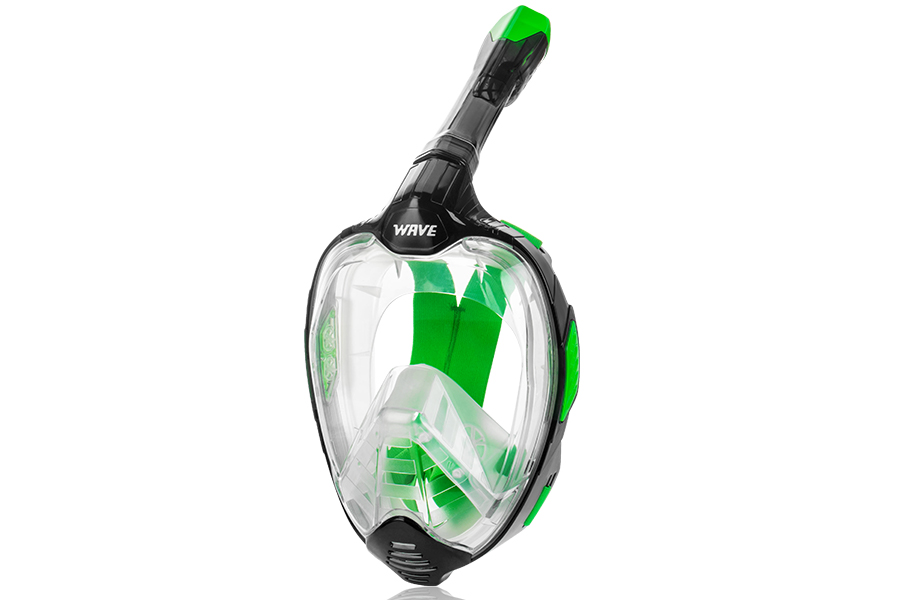
A Vollgesichts-Schnorchelmaske, auch genannt Vollgesichts-Tauchmaskeist ein revolutionäres Gerät, das Maske und Schnorchel in einer Einheit vereint. Entwickelt, um das gesamte Gesicht bedecken, bietet sie eine breitere Sicht und ein natürlicheres Atemerlebnis. Der Zweck dieser Maske ist es, Schnorchlern Komfort und Bequemlichkeit zu bieten, insbesondere Anfängern, die die herkömmliche Maske möglicherweise einschüchternd finden.
Wie funktionieren Vollgesichts-Schnorchelmasken?
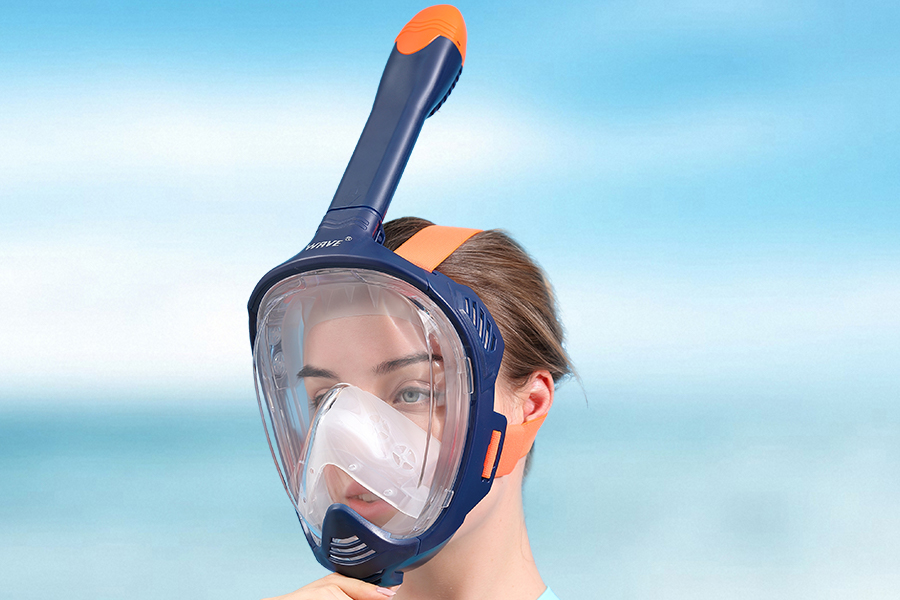
Es integriert Maske und Atemschlauch in eine Einheit. Die Atmung erfolgt natürlich durch Nase und Mund, und die Maske bedeckt das gesamte Gesicht und bietet so eine Panoramasicht unter Wasser.
Vor- und Nachteile von Vollgesichts-Schnorchelmasken
Bevor Sie Vollgesichts-Schnorchelmasken verwenden, sollten Sie deren Vor- und Nachteile prüfen, um herauszufinden, welche Option am besten zu Ihren Unterwasserabenteuern passt.
Vorteile
- Verbessertes Atemerlebnis
- Größere Benutzerfreundlichkeit für Anfänger
- Weniger Beschlag- und Leckageprobleme
Verbessertes Atemerlebnis: Im Gegensatz zu herkömmlichen Masken können Sie bei Vollgesichts-Schnorchelmasken sowohl durch Nase als auch durch Mund atmen. Diese Funktion beseitigt das unangenehme Atmen durch einen Schnorchel und fördert einen natürlicheren Atemrhythmus.
Mehr Bedienkomfort für Einsteiger: Vollgesichtsmasken sind ideal für Anfänger, da sie ein Gefühl von Sicherheit und Vertrauen im Wasser vermitteln. Das größere Sichtfeld trägt außerdem dazu bei, Klaustrophobiegefühle zu reduzieren.
Weniger Beschlag- und Leckageprobleme: Fortschrittliche Belüftungssysteme in Vollgesichts-Schnorchelmasken minimieren das Beschlagen und sorgen für klare Sicht unter Wasser. Die wasserdichte Abdichtung verhindert zudem das Eindringen von Wasser in die Maske und verhindert so Leckagen.
Nachteile
- Mögliche CO2-Ansammlung
- Schwierigkeiten beim Druckausgleich
- Eingeschränkte Anpassungsmöglichkeiten
Mögliche CO2-Ansammlung: Vollgesichtsmasken bilden ein geschlossenes System, das ausgeatmetes Kohlendioxid (CO2) einschließen kann. Dies kann bei unsachgemäßer Handhabung zu Atembeschwerden führen. Befolgen Sie unbedingt die Herstelleranweisungen und atmen Sie häufig kräftig aus, um eine CO2-Ansammlung zu vermeiden.
Schwierigkeiten beim Druckausgleich: Der Druckausgleich ist beim Schnorcheln in größeren Tiefen entscheidend. Vollgesichtsmasken können beim Schnorcheln aufgrund fehlender Nasentasche Schwierigkeiten beim Druckausgleich bereiten. Es ist wichtig, Druckausgleichstechniken zu üben oder für tiefere Tauchgänge auf herkömmliche Masken zurückzugreifen.
Eingeschränkte Anpassungsoptionen: Vollgesichtsmasken zum Schnorcheln sind für eine Vielzahl von Gesichtsformen und -größen geeignet, bieten aber möglicherweise nicht den gleichen Grad an Anpassungsmöglichkeiten wie herkömmliche Masken. Personen mit individuellen Gesichtszügen können es schwierig finden, eine gute Passform zu erreichen.
Was ist eine traditionelle Schnorchelmaske?
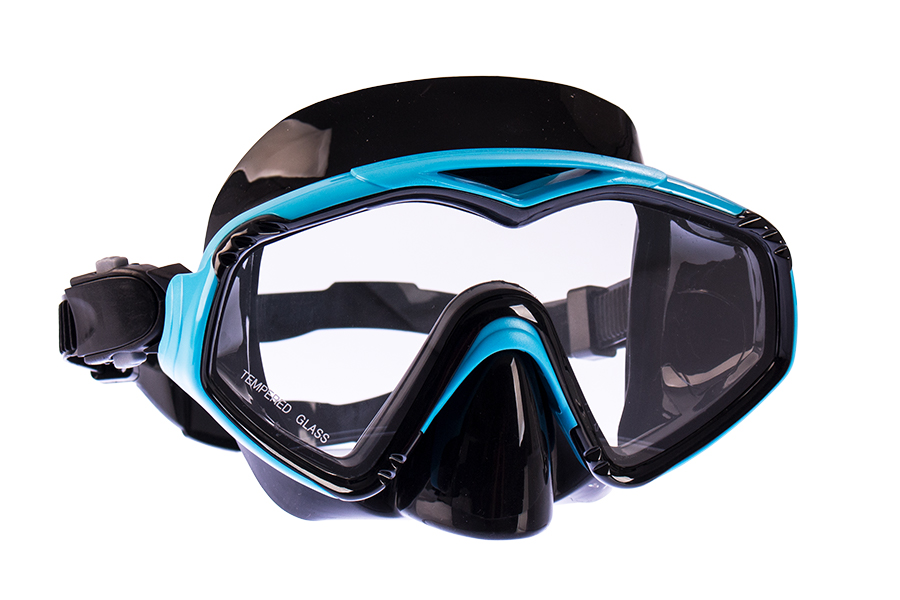
Ein traditionelles Masken- und Schnorchelset, auch genannt eine Halbmaske, Tauchmaske oder Scuba-Maske, besteht aus einer Schnorchelmaske, Schnorchelrohrund möglicherweise ein Paar SchnorchelflossenDiese Masken bedecken Sie nur Augen, Nase und Mund, wobei der Rest des Gesichts frei bleibt. Traditionelle Masken werden seit Jahren verwendet und sind für ihre Zuverlässigkeit und Vielseitigkeit bekannt.
Wie funktionieren herkömmliche Schnorchelmasken?
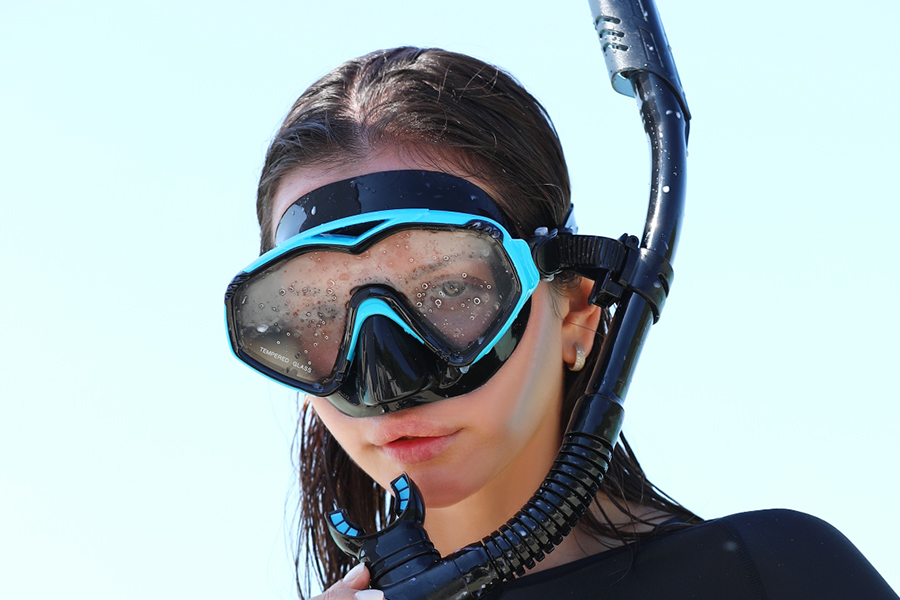
Es besteht aus mehreren Teilen: einer Maske, die Augen und Nase bedeckt, und einem Atemschlauch, der über die Wasseroberfläche hinausragt. Der Benutzer atmet durch den Mund über den Schlauch, während die Maske die Sicht unter Wasser ermöglicht.
Vor- und Nachteile herkömmlicher Schnorchelmasken
Bevor Sie herkömmliche Schnorchelmasken verwenden, sollten Sie deren Vor- und Nachteile prüfen, um herauszufinden, welche Option am besten zu Ihren Unterwasserabenteuern passt.
Vorteile
- Einstellbare Passform für individuelle Vorlieben
- Einfaches Entfernen von Wasser aus der Maske
- Möglichkeit, Teile bei Bedarf auszutauschen
Einstellbare Passform für individuelle Vorlieben: Traditionelle Schnorchelmasken Sind oft mit verstellbaren Riemen ausgestattet, die eine individuelle Passform ermöglichen. Dies gewährleistet Komfort und minimiert das Eindringen von Wasser beim Schnorcheln.
Einfaches Entfernen von Wasser aus der Maske: Herkömmliche Masken bieten Schnorchlern die Möglichkeit, das Wasser durch kräftiges Ausatmen durch die Nase leicht aus der Maske zu entfernen.
Möglichkeit, Teile bei Bedarf auszutauschen: Wenn eine Komponente eines herkömmlichen Schnorchelmaskensets beschädigt oder abgenutzt wird, lässt sich das entsprechende Teil normalerweise problemlos ersetzen, ohne dass eine komplett neue Maske gekauft werden muss.
Nachteile
- Lernkurve für Atemtechniken
- Mögliche Leckage- und Beschlagprobleme
- Geringeres Sichtfeld im Vergleich zu Vollgesichtsmasken
Lernkurve für Atemtechniken: Für Schnorchelanfänger kann es schwierig sein, mit einer herkömmlichen Maske die richtige Atemtechnik zu erlernen. Ausschließlich durch den Mund zu atmen, kann sich anfangs ungewohnt anfühlen, wird aber mit etwas Übung zur Selbstverständlichkeit.
Mögliche Leckage- und Beschlagprobleme: Herkömmliche Masken können manchmal undicht sein oder beschlagen, was die Sicht und das Schnorchelerlebnis beeinträchtigen kann. Regelmäßige Wartung und korrekte Passform können helfen, diese Probleme zu minimieren.
Geringeres Sichtfeld im Vergleich zu Vollgesichtsmasken: Herkömmliche Masken haben ein kleineres Sichtfeld, wodurch die periphere Sicht eingeschränkt ist. Dies kann bei der Erkundung von Unterwasserlandschaften und Meereslebewesen ein Nachteil sein.
Unterschiede zwischen Vollgesichts- und herkömmlicher Schnorchelmaske
Die Wahl zwischen Vollgesichts- und herkömmlichen Schnorchelmasken kann Ihr Schnorchelerlebnis stark beeinflussen. Während herkömmliche Masken ein klassisches Design bieten, bieten Vollgesichtsmasken ein komfortableres und intensiveres Erlebnis mit einzigartigen Funktionen und Vorteilen, die sie auszeichnen. Die Unterschiede liegen jedoch nicht nur im äußeren Design, sondern auch in den tieferen Bereichen.
Atmungsmechanismus: Wie sie sich hinsichtlich des Luftstroms unterscheiden
Vollgesichts-Schnorchelmasken bieten den Komfort, sowohl durch die Nase als auch durch den Mund zu atmen, was der natürlichen Atmung ähnelt.
Im Gegensatz dazu beruht die Atmung bei herkömmlichen Schnorchelmasken ausschließlich durch den Mund, was sich manchmal einschränkend anfühlen kann.
Sichtfeld: Vergleich von Sichtbarkeit und peripherer Sicht
Eine Vollgesichtsmaske zum Schnorcheln bietet ein breiteres Sichtfeld, da sie das gesamte Gesicht abdeckt und Schnorchlern einen Panoramablick auf die Unterwasserwelt ermöglicht.
Herkömmliche Masken haben ein kleineres Sichtfeld, wodurch die periphere Sicht eingeschränkt ist.
Komfort und Passform: Untersuchung der ergonomischen Aspekte beider Maskentypen
Vollgesichtsmasken sind im Allgemeinen für Anfänger und Personen mit empfindlicher Gesichtshaut angenehmer. Sie bieten einen festen Sitz und machen das Beißen auf ein Mundstück überflüssig.
Herkömmliche Masken können zwar angepasst werden, um eine individuelle Passform zu erreichen, sind aber aufgrund des Drucks auf den Kiefer über längere Zeiträume möglicherweise nicht so bequem.
Vergleichstabelle für Vollgesichts-Schnorchelmasken und herkömmliche Schnorchelmasken
| Arten | Vollgesichts-Schnorchelmaske | Traditionelle Schnorchelmaske |
| Atmungsmechanismus | Ermöglicht das Atmen durch Nase und Mund | Erfordert nur die Atmung durch den Mund |
| Blickfeld | Bietet ein breiteres Sichtfeld und deckt das gesamte Gesicht ab | Bietet einen kleineren Sichtbereich und eingeschränkte periphere Sicht |
| Komfort und Passform | Im Allgemeinen bequemer, fester Sitz ohne Mundstück zum Beißen | Die verstellbare Passform kann bei längerem Tragen zu Unbehagen führen |
| CO2-Ansammlung | Potenzial für CO2-Ansammlung | Keine CO2-Ansammlung |
| Druckausgleich | Kann aufgrund des Fehlens einer speziellen Nasentasche zu Schwierigkeiten beim Druckausgleich führen | Ermöglicht einen leichteren Druckausgleich durch Zuhalten der Nase und sanftes Schnäuzen |
| Anpassungsoptionen | Eingeschränkte Anpassungsmöglichkeiten für Personen mit besonderen Gesichtszügen | Verstellbare Riemen und Optionen für Ersatzteile |
| Benutzerfreundlichkeit für Anfänger | Ideal für Anfänger, vermittelt ein Gefühl von Sicherheit und Selbstvertrauen | Möglicherweise ist etwas Übung erforderlich, um sich an die Atemtechniken zu gewöhnen |
| Wasserreinigung | Fortschrittliche Belüftungssysteme reduzieren das Beschlagen; eine wasserdichte Versiegelung verhindert das Auslaufen | Kann auslaufen und beschlagen, erfordert regelmäßige Wartung für optimale Leistung |
| Schnorchelbedingungen | Ideal für ruhige, flache Gewässer | Geeignet für verschiedene Bedingungen, einschließlich tieferer Tauchgänge |
| Empfohlen für | Anfänger, Personen mit empfindlicher Gesichtshaut | Diejenigen, die eine herkömmliche Maske bevorzugen und mit der Atmung nur durch den Mund zufrieden sind |
Was ist besser: Vollgesichtsmaske oder herkömmliche Schnorchelmaske?
Wenn es um Vollgesichts-Schnorchelmasken im Vergleich zu herkömmlichen Schnorchelmasken geht, ist die Frage, welche besser ist, subjektiv und hängt von verschiedenen Faktoren ab.
Erfahrungsstufe: Vollgesichts-Schnorchelmasken sind ideal für Anfänger, da sie bequem und einfach zu handhaben sind. Traditionelle Masken eignen sich besser für erfahrene Schnorchler, die nur durch den Mund atmen können.
Komforteinstellungen: Vollgesichtsmasken bieten mehr Komfort und eine bequeme Passform, während herkömmliche Masken für eine individuelle Passform angepasst werden können.
Schnorchelziele: Vollgesichtsmasken eignen sich hervorragend für ruhige, flache Gewässer, während herkömmliche Masken vielseitiger sind und sich für verschiedene Bedingungen, einschließlich tieferer Tauchgänge, eignen.
Alles in allem sind Vollgesichtsmasken zum Schnorcheln für Anfänger und Personen mit empfindlicher Gesichtshaut geeignet, während herkömmliche oder normale Schnorchelmasken für diejenigen geeignet sind, die gerne nur durch den Mund atmen.
Abschluss
Die Wahl der richtigen Schnorchelmaske ist entscheidend für ein erfülltes und angenehmes Schnorchelerlebnis. Wir haben die Unterschiede zwischen Vollgesichts- und herkömmlichen Schnorchelmasken untersucht und ihre Vor- und Nachteile abgewogen. Letztendlich hängt die Entscheidung von persönlichen Vorlieben, Komfort und den spezifischen Schnorchelbedingungen ab. Nehmen Sie sich Zeit, Ihre Bedürfnisse zu beurteilen und befolgen Sie die Richtlinien, um eine fundierte Entscheidung zu treffen. Weitere Informationen zum Schnorcheln finden Sie auch unter Alles, was Sie über Schnorcheln wissen müssen.
FAQs zur Schnorchelmaske
- Wie funktioniert die vollständige–Funktioniert die Gesichts-Schnorchelmaske?
Eine Vollgesichts-Schnorchelmaske bedeckt das gesamte Gesicht, bietet ein größeres Sichtfeld und ermöglicht Schnorchlern das Atmen durch Nase und Mund. Sie verfügt über eine separate Kammer für die Ausatemluft und ein fortschrittliches Belüftungssystem, das das Beschlagen minimiert und einen optimalen Luftstrom gewährleistet.
- So messen Sie einen vollen–Gesichts-Schnorchelmaske?
Um die richtige Größe für eine Vollgesichts-Schnorchelmaske zu bestimmen, messen Sie den Abstand vom Nasenrücken bis zur Unterseite Ihres Kinns.
- Welche Größe der Schnorchelmaske benötige ich?
Die Größe der Schnorchelmaske hängt von den individuellen Gesichtsmaßen ab. Die meisten Hersteller bieten Größentabellen an, die Gesichtsmaße mit der Maskengröße in Beziehung setzen. Für eine optimale Passform und optimale Leistung ist es wichtig, diese Richtlinien zu befolgen.
- Sind voll–Sind Gesichts-Schnorchelmasken sicher?
Bei korrekter Anwendung und Beachtung der Herstellerhinweise können Vollgesichts-Schnorchelmasken sicher sein. Es ist wichtig, sich der möglichen CO2-Ansammlung bewusst zu sein und die richtige Atemtechnik zu üben. Schnorchler sollten außerdem ihre Grenzen kennen und die Maske regelmäßig überprüfen und warten, um optimale Sicherheit zu gewährleisten.
- Wie atmet man unter Wasser mit einer Schnorchelmaske?
Atmen Sie unter Wasser mit einer Schnorchelmaske, indem Sie auf korrekten Sitz und Dichtheit achten. Halten Sie das Schnorchelrohr über Wasser, entspannen Sie Ihren Kiefer und atmen Sie langsam durch den Mund. Atmen Sie sanft aus, um das Wasser aus dem Schnorchel zu entfernen. Machen Sie Pausen und üben Sie gute Atemtechniken.
